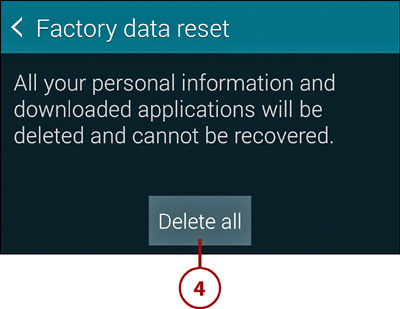20. Optimizing and Troubleshooting

In this chapter, you learn to use your phone more efficiently by managing your plan, available storage, and memory; adding a memory card; updating system software; and performing basic troubleshooting. Topics include the following:
![]() Using Task Manager to manage memory
Using Task Manager to manage memory
![]() Conserving the battery manually and by enabling special modes
Conserving the battery manually and by enabling special modes
![]() Making the most of your talk and data plans
Making the most of your talk and data plans
There’s more to understanding your Galaxy S5 than making phone calls and mastering a handful of favorite apps. This chapter delves into material that you don’t need to commit to memory or even read immediately—but when you need it, you’ll be happy to have it. Bonus content from this chapter can be viewed at the book’s website, www.informit.com/title/9780789753496. (Look on the Downloads tab.) Information includes formatting and removing a memory card, installing and replacing the SIM card, checking for system updates, troubleshooting, and performing a Factory Data Reset.
Managing Memory
You’ve noticed that most apps don’t have a Quit or Exit command. That’s because the Android operating system is designed to handle memory management behind the scenes. If free memory is running low, for example, unnecessary processes automatically shut down. However, if you occasionally feel the need to take a hands-on approach to quitting apps and freeing memory, you can use the Task Manager.
1. Tap the Recent Apps key. A vertically scrolling list of apps that you’ve recently run or are currently running appears.
2. Launch the Task Manager by tapping its icon.
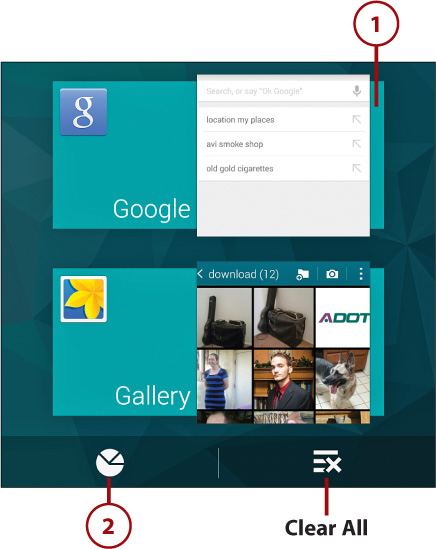
Other Actions
In addition to launching the Task Manager, you can tap any app thumbnail in the Recent Apps list to launch or switch to that app. To remove an item from the list, swipe it horizontally off-screen. To remove all items from the list, tap the Clear All icon.
3. Task Manager lists the currently running apps. To close an app, tap its End button. To simultaneously close all running apps, tap End All.
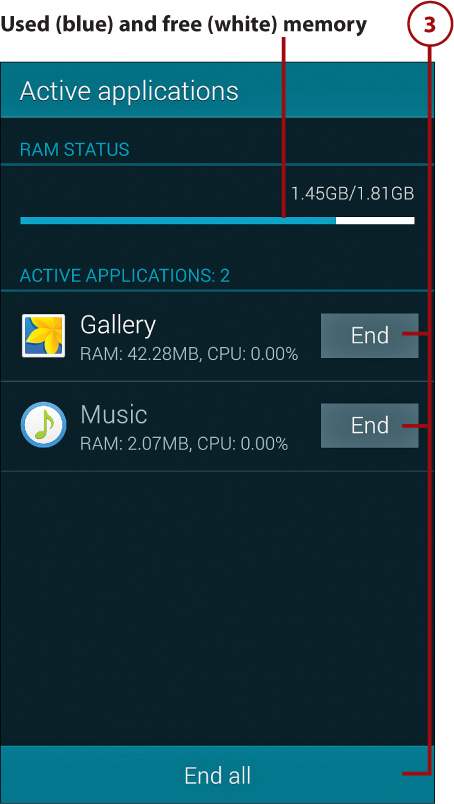
4. Tap OK in the End or End All confirmation dialog box.
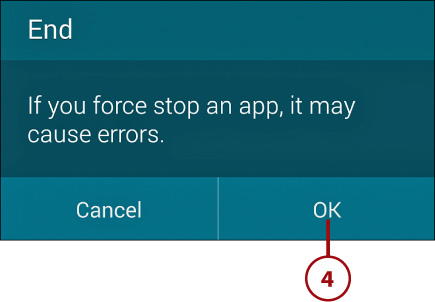
Switch to a Running App
As in the Recent Apps list, you can tap the name of any running app—if its name is displayed in white text—to switch to it.
Conserving the Battery
Depending on how frequently you use the phone and what you typically do with it, there are several approaches to conserving the battery. First, you can automatically conserve the remaining charge by enabling Power Saving mode or the new Ultra Power Saving mode. Second, if you prefer to take the manual approach, you can disable features that aren’t currently needed or change certain default settings so that less power is used. Finally, to monitor how various apps and the operating system use the battery, you can open Battery settings.
Configure and Enable Power Saving Mode
When Power Saving mode is enabled and a low battery level is detected, selected features are automatically changed or disabled to extend the remaining charge.
1. On the Home screen, tap Apps, followed by Settings. Alternatively, you can open the Notification panel and tap the Settings icon.
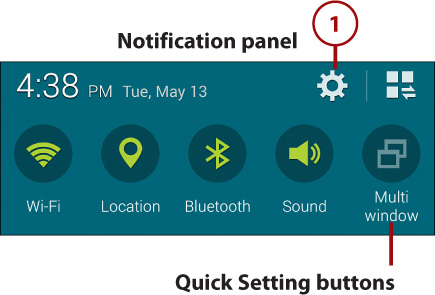
2. In the System section of Settings, tap the Power Saving icon.
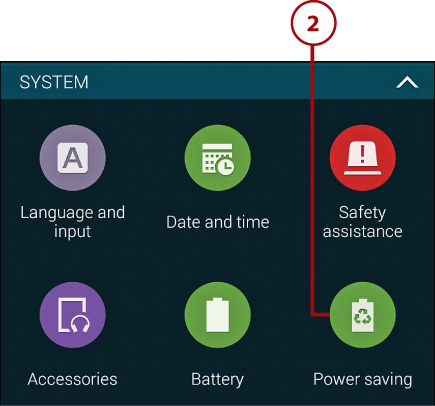
3. Tap Power Saving Mode.
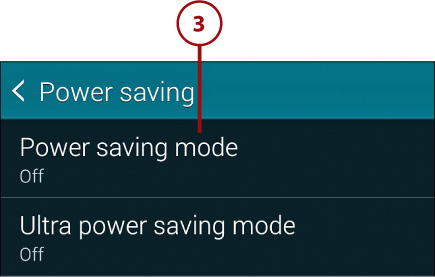
4. Move the Power Saving Mode slider to the On position. When Power Saving mode is enabled, you can selectively enable or disable options by tapping the Block Background Data check box and the Restrict Performance and Grayscale Mode text. Restrict Performance can be further customized by enabling and disabling particular options. Later when you elect to enable Power Saving mode, the settings specified here are applied collectively.
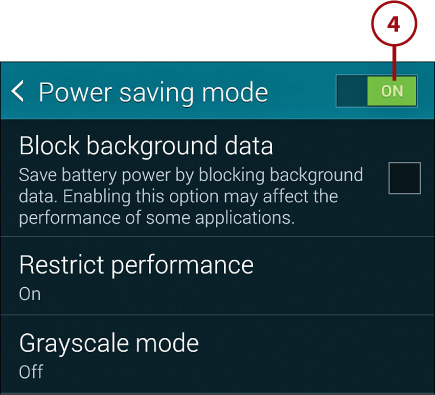
If you don’t need to change the Power Saving mode settings, you can quickly enable or disable Power Saving mode by opening the Notification panel, scrolling the Quick Setting buttons to the right, and tapping the Power Saving icon. (If the icon isn’t in the scrolling list, tap the Grid View icon to display all Quick Setting buttons.) If you want to change Power Saving mode settings, press and hold its button to go directly to the Power Saving mode screen in Settings.
If you frequently need to enable Power Saving mode, you should consider reconfiguring the Quick Setting buttons to add Power Saving as a primary button (see “Customize the Quick Setting Buttons” in Chapter 3, “Making the Phone Your Own”). Note that these comments apply equally to Ultra Power Saving mode.
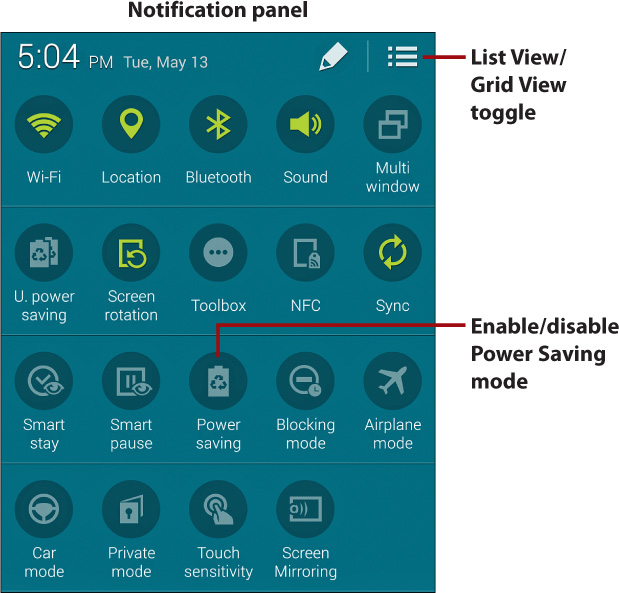
Configure and Enable Ultra Power Saving Mode
When you’re severely short on battery charge, you can squeeze even more work out of your phone by enabling Ultra Power Saving mode.
1. Perform Steps 1 and 2 of the “Configure and Enable Power Saving Mode” task, and tap Ultra Power Saving Mode.
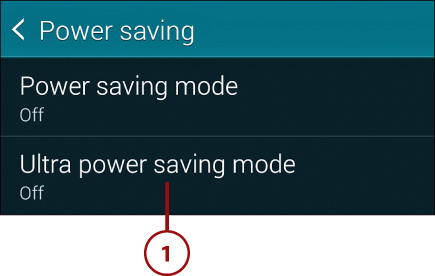
2. Read the description and then move the Ultra Power Saving Mode slider to On.

3. Read the mode restrictions that will be applied and tap OK. Ultra Power Saving mode is immediately applied to your phone and its temporary Home screen appears.
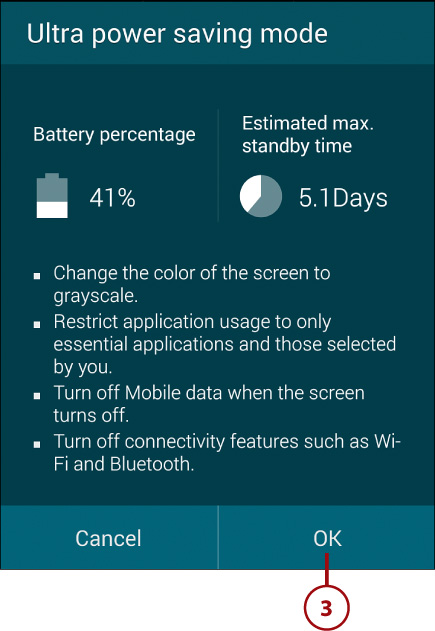
Tips for Manually Conserving the Remaining Charge
If the battery is commonly draining too quickly or you want to extend usage time when the battery is almost depleted, you can manually change certain settings as needed or set new defaults.
• If you aren’t currently using some services, such as Location (GPS), Bluetooth, or Wi-Fi, disable them in the Notification panel by tapping their Quick Setting buttons. Turn them on again only when you need them.
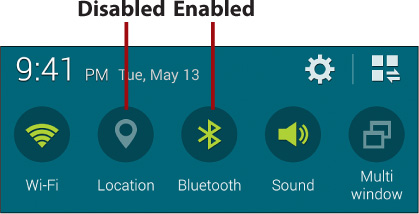
• The phone’s screen draws considerable power. Consider reducing the Screen Timeout value or the Brightness setting (Settings, Display). You can also adjust Brightness by dragging the slider near the top of the Notification panel. Whenever you’re done using the phone for a bit, tap the Power button to instantly darken the display—rather than waiting for the Screen Timeout.
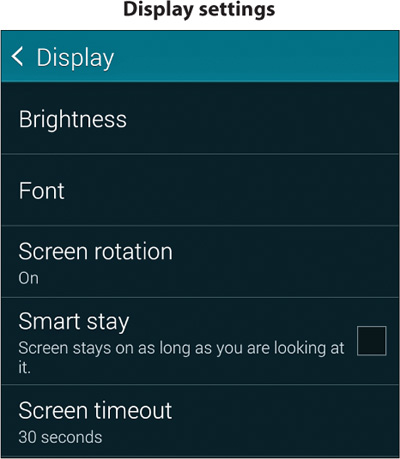
• Consider checking less frequently for new email. For unimportant email accounts, you could set the frequency to Once a Day or Manual, for example. You can still perform manual checks as often as you want. To change the retrieval frequency, launch Email, tap the menu icon, choose Settings, tap Manage Accounts, and select the account that you want to manage. Tap Sync Settings, Sync Schedule, and Set Sync Schedule; and then select a new sync/retrieval frequency.
• Avoid battery-intensive activities. Playing videos and games prevents the display from timing out. Streaming videos or music transfers large amounts of data to the phone, requiring that the connection be constantly active.
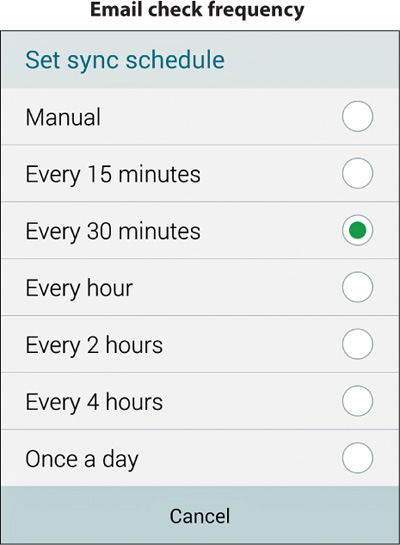
• In standby mode, the phone consumes little battery power. Although it may be sacrilege to suggest this, you can take things a step further by powering off the phone when you won’t need it for an extended period. For instance, if you never answer the phone after you go to bed, consider turning it off nightly—or leave it on while you charge it during this period.
Plug It In
Before the battery dies, you can continue a conversation and other activities by quickly plugging the phone into a wall outlet or USB port. The phone charges as you continue to work. When your call or app activity concludes, power off the phone and allow the battery to charge normally.
Because you never know when you’ll need to recharge, you should consider buying an extra charging cable or two. Keep the spares at key locations—at work and in the car, for example.
View Battery Usage by Features and Apps
If you want to get a handle on which features and applications are draining your battery the most, you can find the answer in Settings.
Low Battery Indicator
If you want to be warned when the battery is extremely low, a blinking red LED can automatically appear when the screen is dark. Open Settings, tap the Display icon, tap LED Indicator, and ensure that Low Battery is checked.
1. Open Settings and tap the Battery icon (in the System section).
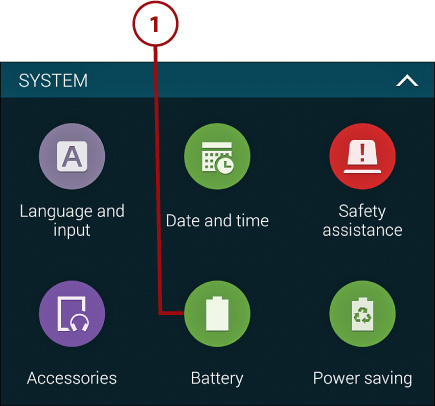
2. The scrolling summary lists the features, services, and apps that have been consuming the battery since the last time you charged the phone and shows the percentage of consumption attributable to each.
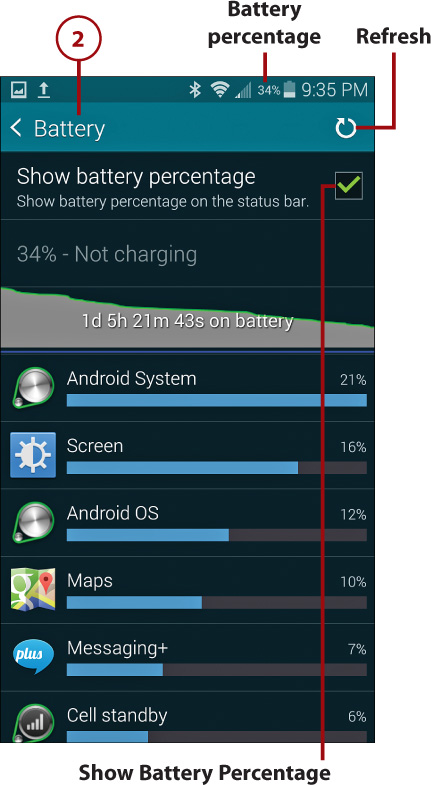
Refreshing the Data
While viewing the Battery screen, you can force a refresh to display up-to-date consumption figures.
3. Optional: Tap an entry to view additional information. Depending on the item, you may be able to alter its settings to reduce battery consumption, disable or execute a force stop for it, or uninstall it.
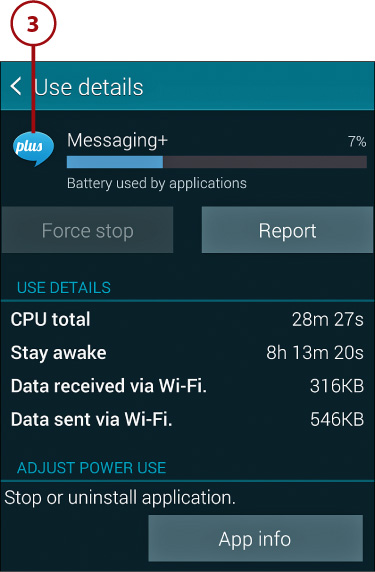
Show the Battery Percentage
Although the battery indicator in the status bar gives a rough indication of the remaining charge, you can alter it to show the percentage remaining. Ensure that Show Battery Percentage is checked (see the figure for Step 2).
Managing Talk Time and Data Usage
If you’re on a limited talk, messaging, or data plan, the key to avoiding overage charges is relatively simple: Know and monitor your plan.
Checking Current Usage
Each carrier generally offers several ways for you to check the current month’s usage, as well as manage your account. For example, depending upon your carrier, you might be able to take advantage of one of these built-in apps: AT&T (myAT&T), Sprint (Sprint Zone), T-Mobile (T-Mobile My Account), or Verizon (My Verizon Mobile).
Carriers typically provide a phone number that you can call to check your minutes and other usage. For example, Sprint users can dial *4 from their cell phone; Verizon users can dial *611.
You can also check the carrier’s website. At a minimum, you should see your usage for the current billing cycle. In addition, there might be an option to automatically receive a notification via text or email if you come close to exceeding a plan limit. Forewarned is forearmed. For example, when you discover or are notified that you’re precariously close to hitting your monthly data limit, you can take steps to ensure that additional data-intensive activities (such as streaming videos or music) occur only over Wi-Fi. You may be able to request similar notification for other costly situations, such as international roaming.
Manage Data Usage
If your data plan has a monthly limit, you can enable the Data Usage setting on the phone to automatically warn you when you come close to exceeding your data limit—ignoring data transmitted over Wi-Fi, which doesn’t count toward usage. You can also manually disable mobile data (using the cell network to transmit data) if you’re close to exceeding your plan limit.
1. Open Settings and tap the Data Usage icon (in the Network Connections or Quick Settings section). The Data Usage screen appears.
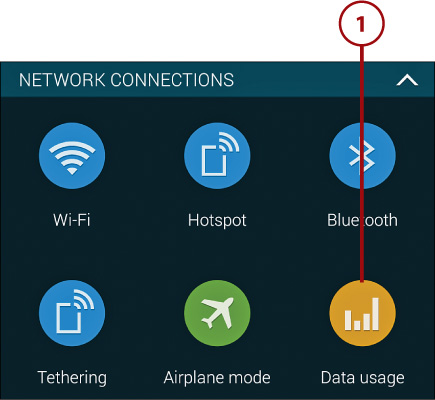
2. The Mobile Data setting determines whether the cell network can be used to transfer data to and from the phone (checked) or whether you’re restricting the phone to Wi-Fi data transfers (unchecked). If you’re close to or have exceeded your monthly plan limit, remove the check mark to prevent additional overage charges.
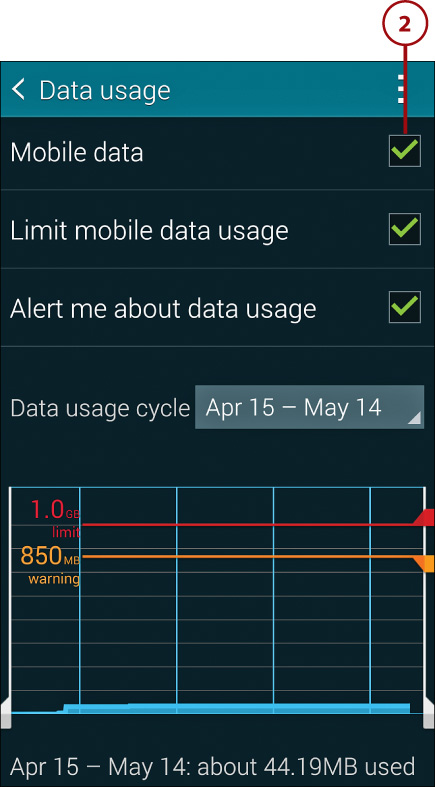
3. Tap the Limit Mobile Data Usage check box to instruct the phone to automatically disable mobile data when your plan limit is reached (red line). Read the explanatory material in the dialog box that appears and tap OK. When mobile data is disabled, you must do additional data transfers over Wi-Fi.
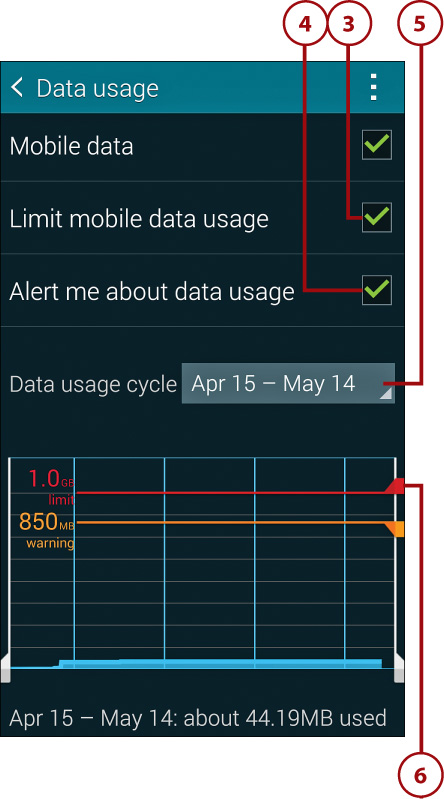
4. Tap the Alert Me About Data Usage check box to instruct the phone to warn when you’re approaching your monthly limit (orange line). Read the explanatory material in the dialog box that appears and tap OK.
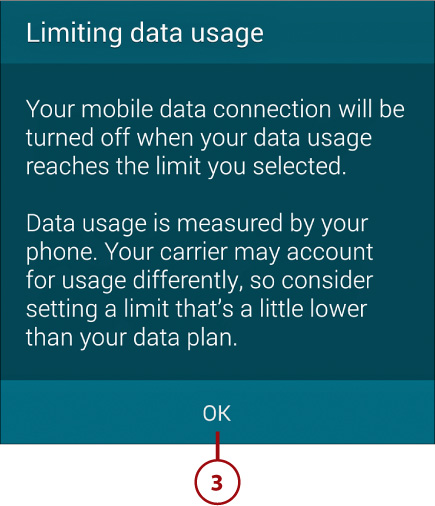
5. Ensure that the Data Usage Cycle matches your monthly billing cycle and represents the current cycle. If the billing period is incorrect, tap it, choose Change Cycle, specify the date when the usage cycle resets, and tap Set. If the cycle is incorrect, tap it to select a different 30-day period.
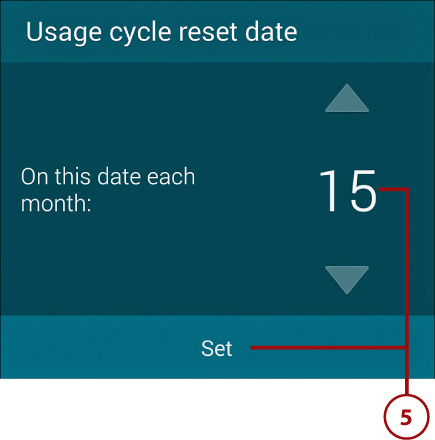
6. Set the red slider to match your plan’s data limit (in gigabytes), set the orange slider to reflect the usage amount at which you want to be warned, and set the white bars to the period that you want to monitor.
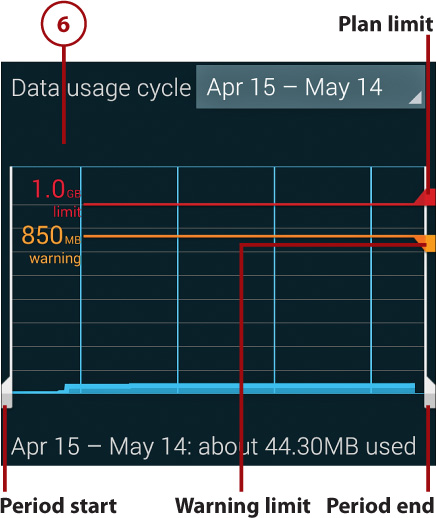
7. Tap the menu icon to enable or disable these additional Data Usage options:
• Enable Data Roaming to allow your phone to use other networks for data access when roaming.
• Enable Restrict Background Data to prevent background data access of apps and services, restricting them to working only when a Wi-Fi connection is available.
• Enable Auto Sync Data if you want your accounts to sync automatically—regardless of whether only a cellular connection is available.
• Enable Show Wi-Fi Usage to add a separate Wi-Fi tab to the Data Usage screen, showing the last 30 days of Wi-Fi data usage and the apps that contributed to the usage. You aren’t billed for Wi-Fi data usage, so it can be useful to see how much of your usage was free (Wi-Fi) versus paid (cellular).
• Tap Mobile Hotspots to view enabled Wi-Fi hotspots within range of your phone.

What’s Cheaper?
If you have unlimited or inexpensive text messaging, it may be advantageous to send texts rather than make short calls. Conversely, if you’re billed 25![]() per message, it may be cheaper to call. Note that your carrier may allow you to block incoming text messages (see your carrier’s website for details). Received text messages—including unwanted ones—may be billed to your account at the same rate as messages that you send.
per message, it may be cheaper to call. Note that your carrier may allow you to block incoming text messages (see your carrier’s website for details). Received text messages—including unwanted ones—may be billed to your account at the same rate as messages that you send.
Can This Call Be Made Later?
The distinction between free and paid calls is typically determined by the time of day at the location where you make the call. If your free minutes begin at 7:00 p.m. each weeknight, for example, try to reserve lengthy, chatty calls for evenings and weekends.
If you’re traveling and are in a different time zone, your daytime and evening calling periods generally change to match the local time. That is, free calling still begins at 7:00 PM—in whatever time zone you happen to be. Before heading out, check your plan to be sure. Similarly, if you’re leaving the country, ask how out-of-country minutes are billed. Thinking that he was covered or that the rate would be reasonable, a friend didn’t bother to check beforehand and returned to discover that his handful of international calls resulted in a bill of several hundred dollars.
Prorated Features
If your carrier plan allows you to add or remove features as needed, you might be able to save money by removing them as soon as you’re finished using them rather than waiting until the end of the billing cycle. For example, I had to add the mobile hotspot and tethering feature to my plan in order to discuss how they worked in this book. When I finished a few days later, I immediately removed the feature from my plan. As a result, I was only charged one-tenth of the feature’s full-month cost.
Faster Downloads with Download Booster
Although most U.S. carriers eliminated this highly touted feature before shipping their version of the S5, a few decided to support it—at least initially. When downloading files more than 30MB, Download Booster enables you to simultaneously use your Wi-Fi and cellular data connections to download the file faster. To enable Download Booster, open Settings, tap the Download Booster icon, move the slider to the On position, and then tap OK in the pop-up that appears.
Viewing and Expanding Storage
Although the 16GB version of the Galaxy S5 has approximately 11GB of internal memory available for storage, you can exhaust it with a combination of apps, photos, videos, music, and other data. You can expand your available storage by inserting a microSD (Secure Digital) or microSDHC (Secure Digital High Capacity) card into the phone’s internal slot, adding as much as an additional 128GB.
View Used and Available Space
You can consult Storage to view the total, used, and available storage/memory on your phone.
1. Open Settings and tap the Storage icon (in the System section).

2. The Device Memory bar shows how the phone’s built-in memory is being used. The colored sections of the bar represent the built-in storage that’s currently in use, and the dark gray area on the right (Available Space) shows the amount of free space.
• Total Space is the phone’s built-in storage. It is used for the Android operating system, running apps, and storing all types of data (such as photos, music, videos, downloaded apps, and system files). Total Space does not include storage available on an add-in memory card, if you have one.
• System Memory is the amount used by the Android operating system.
• An SD Card section is shown at the bottom if there’s an installed microSD or microSDHC card. Total Space is the amount of storage space available on the card after it has been formatted for use by the Android operating system. Available Space is the amount of free space on the card that can be used to store additional files.
3. Optional: Tap Used Space and Miscellaneous Files to view a breakdown of the storage space used by different types of data.
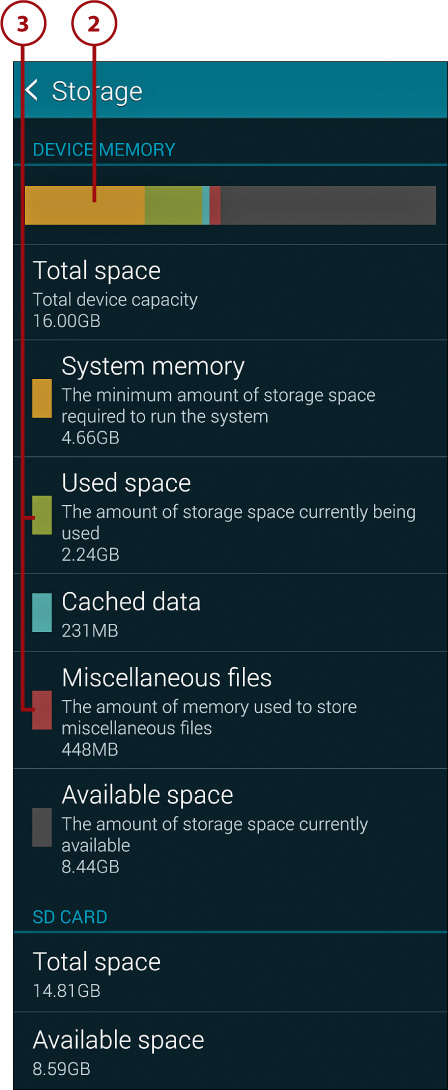
When viewing the information in Storage, you may think that the total space listed is less than the stated specs. Don’t be alarmed; the figures are correct. Although the Galaxy S5 includes at least 16GB of internal storage, part of it is used as system memory. And when formatted for use, a 16GB microSDHC card has only 14.81GB of usable space, for example.
Adding a Memory Card
The Galaxy S5 can accommodate up to a 128GB memory card in its internal slot. When picking a card, take note of its class in the item description. The lower the class number (2–10), the slower the card. Under current class specifications, the class indicates the card’s minimum sustained write speed in megabytes per second. Thus, a Class 2 card should be capable of writing data to the card at 2MBps (megabytes per second) or faster. (If a card’s description or packaging doesn’t mention a class, assume that it’s Class 2 or slower. That frequently explains why such cards are so inexpensive.) Currently, you can purchase Class 10 cards for less than 75![]() per megabyte. Unless you already have an older, slower card, there’s little monetary incentive to go slower than Class 10.
per megabyte. Unless you already have an older, slower card, there’s little monetary incentive to go slower than Class 10.
Next, determine the amount of storage you need. An 8GB or 16GB card suffices for most people. If you intend to pack it with videos and music or regularly shoot hundreds of photos or lengthy movies, go for the highest-capacity card you can afford—128GB is the max.
All Cards Aren’t Equal
Even within a class, cards aren’t identical. First, some Class 10 cards can sustain a minimum 10MBps read speed, as well as write speed. Second, the minimum speed on some of these cards is occasionally much faster than 10MBps. Third, based on reviews and ratings on sites such as Amazon.com and NewEgg.com, some cards appear to be knockoffs that are slower than their stated class, fail quickly, or don’t work at all. When choosing a card from an online source, read the user comments, note the ratings, and check the seller’s return policy.
Although it isn’t necessary, make a note of whether your chosen card includes a microSD to SD adapter. If it does, you can slip your tiny card into the postage stamp–sized adapter and use it in devices that require an SD card rather than a microSD card. In the same vein, be sure that your chosen card is a microSD or microSDHC, not an SD or SDHC. Only a micro card will fit in the phone’s slot.
Insert a Memory Card
Whether the card is new or being moved from another phone or device, the first step is to insert it into your phone.
1. Shut down the phone by holding down the Power button, tapping Power Off in the Device Options dialog box, and then tapping OK in the confirmation dialog box.
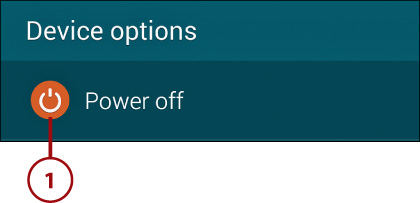
2. Remove the cover from the back of the phone by slipping your thumbnail into the tiny slot on the side (above the Power button) and prying off the back.

3. Grasp the memory card by its edges and turn the card so that its gold contact strips face down. The labeled side of the card should face up and be oriented as it is in the figure.
4. The top of the battery blocks the insertion or removal of memory and SIM cards. Carefully remove the battery by slipping your thumb into the slot at its bottom and prying gently upward.
5. The memory card slot sits atop the SIM card slot. Carefully push the memory card into its slot until it clicks into place, reinsert the battery, and replace the phone’s back cover. Ensure that the cover is completely sealed around all edges.
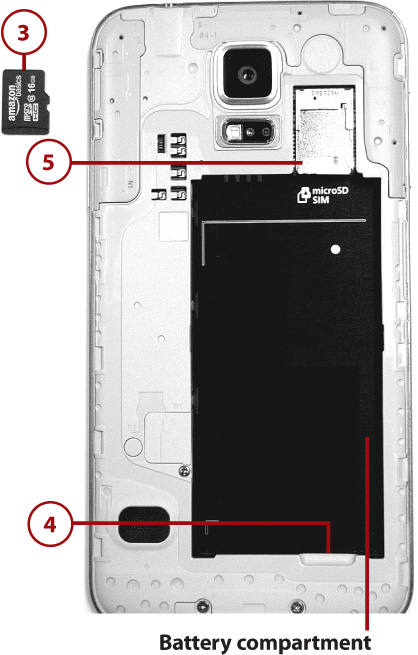
Bonus Content
Format a Memory Card
If the memory card contains unwanted data from another phone or device or isn’t recognized by the phone as formatted, you can format the card (erasing all data and preparing it for use in the phone).
1. Open Settings and tap the Storage icon.

2. Scroll down to the SD Card section. If the card isn’t already mounted, tap Mount SD Card.
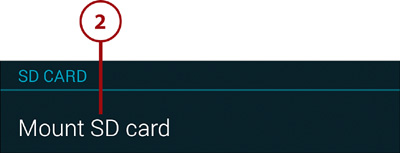

Cards with Foreign Data
If the memory card was last used in a different device, such as a camera or video streaming device, the card may refuse to mount. If this happens, open the Notification panel and tap the entry for the card for an opportunity to format it.
3. Tap Format SD Card.
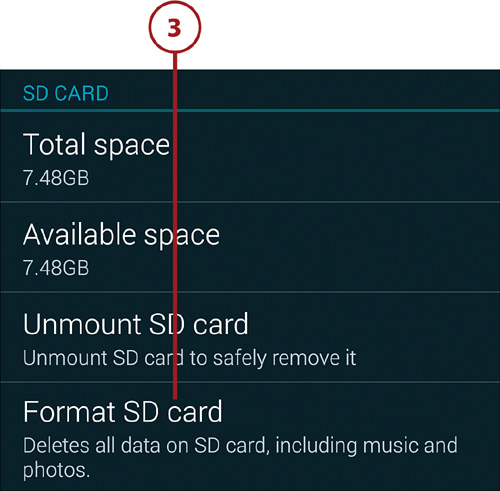
4. Tap the Format SD Card button.
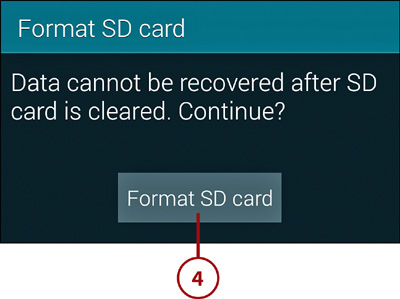

6. The memory card is unmounted, formatted, and remounted to enable the phone to use it.
Remove a Memory Card
The following steps explain how to correctly remove a memory card from the phone to replace it with a different card or to move the card to another device. You begin by unmounting the card so that it can be safely removed.
1. Open Settings and tap the Storage icon.
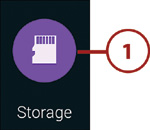
2. Scroll down to the SD Card section and tap Unmount SD Card. Tap OK in the confirmation dialog box.
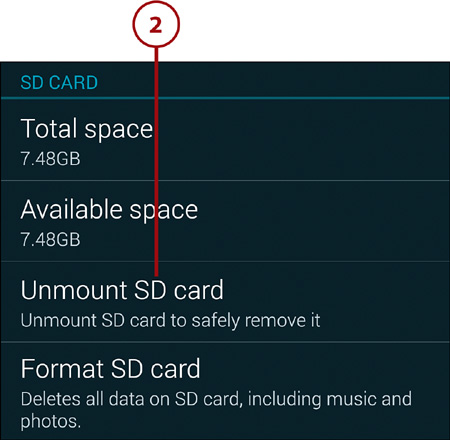
3. Shut down the phone by holding down the Power button, tapping Power Off in the Device Options dialog box, and then tapping OK in the confirmation dialog box.
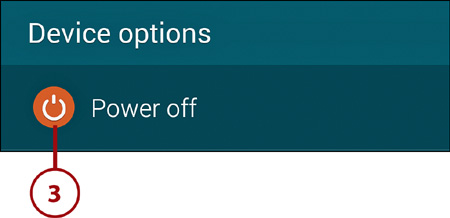
4. Remove the cover from the back of the phone by slipping your thumbnail into the slot on the side (above the Power button) and prying off the back. See the figure in “Insert a Memory Card,” earlier in this section.
5. To free the SD card, press your fingernail behind the card’s raised front edge and slide it out. When handling the card, be sure to grasp it only by its edges.
6. Replace the back cover. Ensure that the cover is completely sealed around all edges.
Use a Memory Card as a USB Drive
By following the instructions in “Manually Transferring Files over USB” in Chapter 16, “Transferring and Sharing Files,” you can mount your phone as an external drive on your Mac or PC (like a flash drive), enabling you to freely copy files in either direction. You can view and access the files on your phone by going to the Home screen and tapping Apps, My Files. In the Local Storage section of My Files, you can see separate icons for the phone’s built-in memory (Device Storage) and your installed memory card (SD Card). Tap these icons to view the files within. If you select a file, open the menu, and choose Details, you’ll note that any file stored in built-in memory has the path prefix / storage/emulated/0/. Files on an installed memory card have the path prefix / storage/extSdCard.
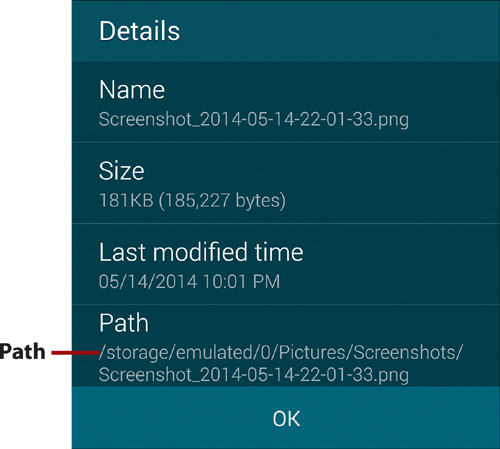
Installing or Replacing the SIM Card
To be recognized by your carrier’s network, every Galaxy S5 must have a carrier-specific Subscriber Identify Module (SIM) card. If the SIM card wasn’t preinstalled when you purchased the phone, follow the procedure and photos in “Insert a Memory Card” to turn off the phone, open the case, and insert the SIM card into its slot (beneath the memory card slot). Ensure that the notched edge goes into the slot first and that the card’s gold contacts face down.
To replace an existing SIM card with a new one, remove the battery and then slide out the SIM card. Slide the new SIM card into the slot—notch first, gold contacts down—until it clicks into place. Finish by replacing the battery and the phone’s back cover.
Checking for System Updates
It’s a good idea to periodically check for system updates. Although you may automatically receive notices of firmware updates, for example, you can still perform manual checks whenever you like, as explained in the following task. The notification method and process of updating to a newer version of the Android operating system and firmware are carrier-dependent. When notified of an available update, refer to your carrier’s website for additional instructions.
Check the Battery First
Before performing any kind of system update (especially firmware and Android), be sure you have sufficient charge to complete the process. Interrupting updates can have dire consequences for the phone.
1. On the Home screen, tap Apps, followed by Settings.

2. Depending on your carrier, do one of the following:
• AT&T. Tap About Device, Software Update, Check for Updates, OK.
• Metro PCS, T-Mobile. Tap About Device, Software Update, Wi-Fi Settings (to download via Wi-Fi) or OK (to download via a cellular connection).
• Sprint. Tap System Update, Update Now.
• U.S. Cellular. Tap About Device, Software Update, OK.
• Verizon. Tap Software Update, Check for New Software Update.

What Version of Android Do I Have?
The About Device or About Phone screen shows the version of the Android operating system that’s currently installed.
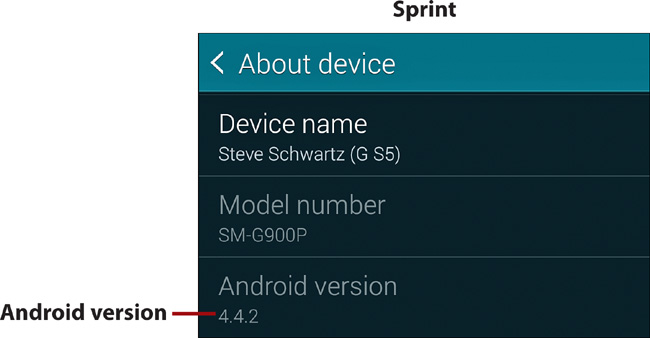
Troubleshooting
This section provides suggestions for correcting simple and complex problems that can arise with the phone.
General Troubleshooting
When trying to correct an app-related or OS-related problem, you should generally work from the least to the most extreme solution.
• Try appropriate button presses. Try pressing the Home or Back key to leave the current screen, or press the Power button.
• Use the Task Manager to close unnecessary apps. (Press the Recent Apps key and then tap the Task Manager icon at the bottom of the screen.)
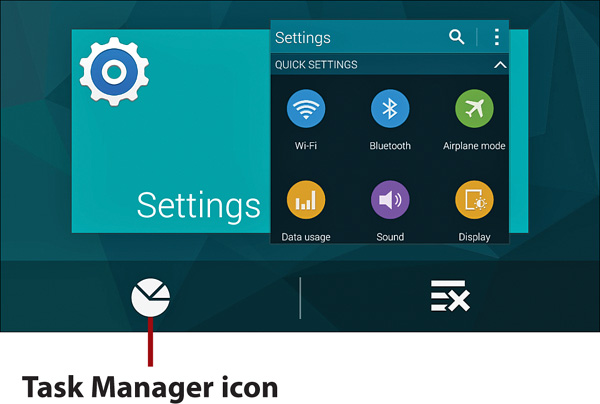
• For app-related issues, check the app’s settings (if it provides them) by tapping the menu icon and choosing Settings. You can also try uninstalling and reinstalling the app to see if the problem is corrected. If the issue continues, check Google Play for an update, visit the developer’s website for troubleshooting information, or consider uninstalling the offending app.
• For battery-drain issues, turn off services that you aren’t currently using, such as GPS, Bluetooth, and Wi-Fi. Open the Notification panel and tap Quick Setting buttons to enable or disable services. (When charging a phone that’s on, turning off these services will generally decrease your recharge time, too.)
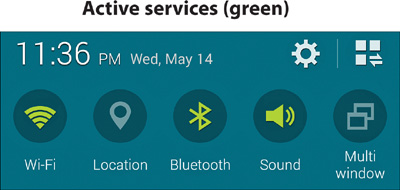
• Restart or shut down the phone by pressing and holding the Power button, tap Restart or Power Off, and then tap OK in the confirmation dialog box.
• To determine if a downloaded app or update is causing the problem, restart the phone in Safe mode (as described in the following section “Testing in Safe Mode”).
• For a complete lock-up or similar issue, remove and replace the battery (as described in the section “Fixing a ‘Lockup’”).
• Perform a Factory Data Reset (as described in the section “Perform a Factory Data Reset”), but only if the phone is so messed up that no other solution remains. Call your carrier’s customer service/technical support before performing this procedure or, if one of its stores is nearby, take the phone in to be checked out.
Testing in Safe Mode
When the phone is in Safe mode, only the standard, built-in apps are active; apps that you’ve downloaded are disabled. If the problem isn’t present in Safe mode, the likely culprit is an app that you’ve recently installed or updated. To enable Safe mode, start by turning the phone off. Then turn the phone back on and—when the Samsung logo appears during the startup sequence—press and hold the Volume down key until the lock screen appears. While Safe mode is active, it’s noted at the bottom of every screen.

While in Safe mode, test to see if the problem persists. If it does, refer to the section “Perform a Factory Data Reset.” On the other hand, if the problem isn’t present in Safe mode, you’ll have to determine which new app is the troublemaker. Uninstall the most recently installed app (see “Uninstall, Disable, and Hide Apps” in Chapter 10, “Installing and Using Applications”), restart the phone normally, and test again. One by one, continue uninstalling the newest apps until the problem goes away. Others that you’ve uninstalled during this testing can generally be reinstalled.
When you’re ready to exit Safe mode, restart the phone normally. If you prefer, you can tap the Safe Mode Is On entry in the Notification panel and then tap Turn Off Safe Mode.
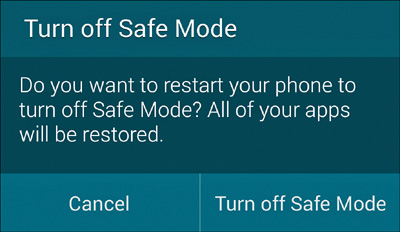
Fixing a “Lockup”
Yes, some apps have bugs, so what you expect to happen sometimes doesn’t match what actually happens. When the worst occurs—the phone locks up so solidly that it ignores all taps, swipes, button presses, and attempts to power down, restart, or recharge—there’s still something you can try. Open the back cover, remove the battery, wait 2 minutes, and reinsert the battery. Note that this is a solution of last resort. If you perform it while the phone is writing to memory, you can lose data.
Perform a Factory Data Reset
Using the Factory Data Reset procedure, you can restore your phone to its initial factory-default apps and settings. If you’re planning to trade it in, sell it, or give it to a family member, performing a Factory Data Reset also removes the applications you’ve installed and erases your personal data, such as contacts, photos, and music files. If this data is important to you, be sure to back it up to a memory card or computer prior to performing the reset.
1. Open Settings, and tap Backup and Reset (in the User and Backup section).
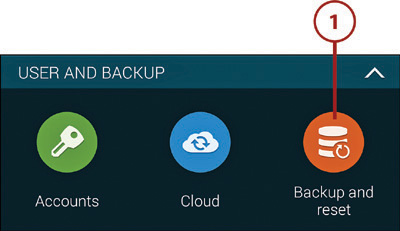
2. Tap Factory Data Reset (in the Personal Data section).
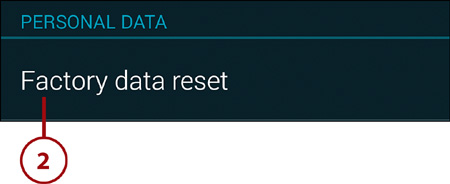
3. Review the explanatory text and tap the Reset Device button at the bottom of the screen.
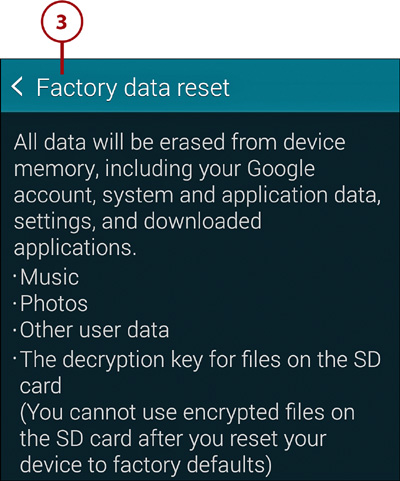
External SD Card Handling
On earlier phones in the Galaxy S line, Factory Data Reset offered to optionally delete data from a user-installed memory card. If you need to erase data from a memory card, perform the “Format a Memory Card” task before performing the Factory Data Reset.
4. Tap the Delete All button to perform the Factory Data Reset. (Or if you’ve changed your mind, press the Back key.) After a Factory Data Reset, the setup wizard automatically runs when you restart the phone, giving you the opportunity to reconfigure it.
